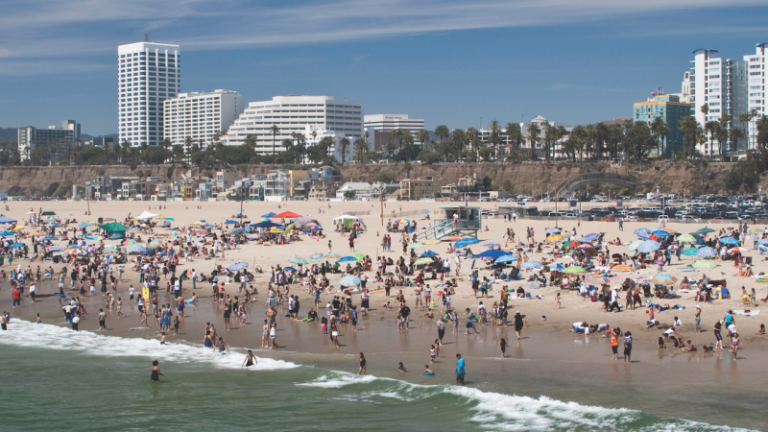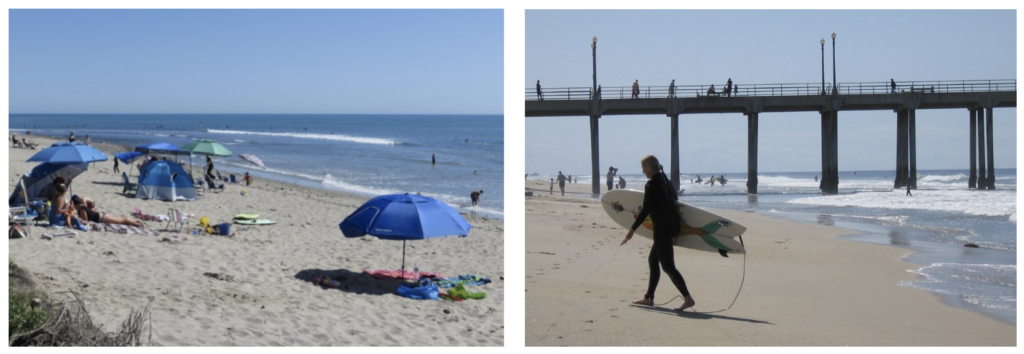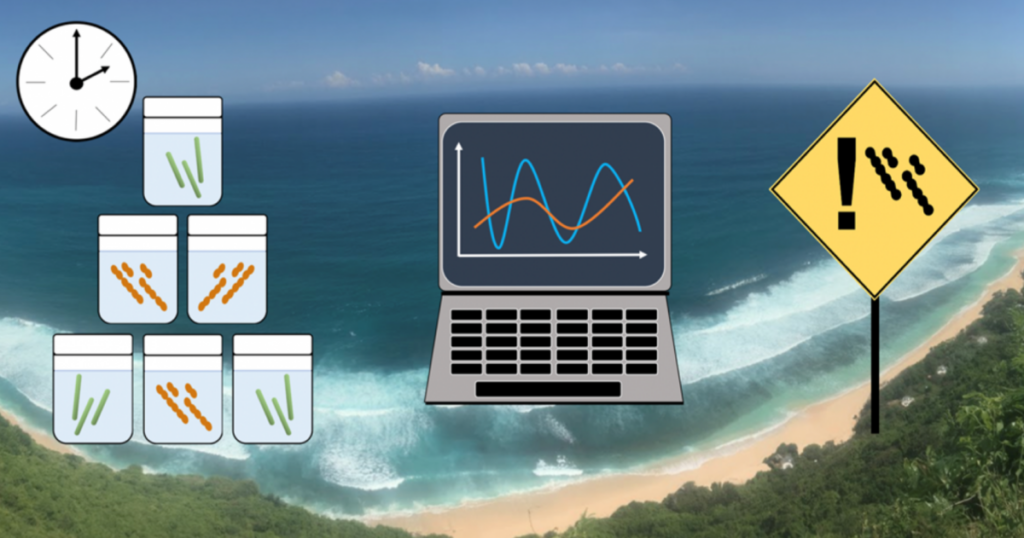
Santa Monica Beach.
Advancing an Early Warning System for California Beach Water Quality
In Southern California, there are over 129 million beach visits yearly,[1] and the region’s economy dependent on coastal tourism and recreation is more than $17.6 billion.[2] As beaches are such a magnet for people, ensuring that the coastal waters are clean and safe for swimming is vital for California’s resource managers.
California’s beaches are known as relaxing, idyllic, natural settings to the large populations that visit them annually. However, one issue that can arise for people who swim or surf in the ocean is exposure to unsafe water conditions. Usually, ocean waters contain contaminants that are below risky levels, but events like rain, increase in stormwater run-off, waste-treatment plant overflows, animal waste, change in currents, and even wind can increase levels of fecal indicator bacteria (FIB) such as enterococci and Escherichia coli. During these situations, people accessing coastal waters contaminated with FIB have an increased risk of getting sick. Recreational waterborne illness caused by FIB usually results in symptoms such as diarrhea, respiratory illness, and skin rashes.
Many water quality monitoring agencies, including those in California, have a two-day laboratory turnaround of beach water samples, and this time-lag often results in the exposure of many beachgoers to contaminated water. For more timely results, some water quality managers have moved to using data-driven models to predict the presence of poor water quality. However, these models to date have required extensive multi-year data sets to be properly trained to accurately predict water quality. This requirement automatically leaves out “data-poor” beaches where monitoring is infrequent or non-existent. Surprisingly, even some popular beaches in Southern California, such as Huntington Beach Pier and San Onofre State Beach, are data-poor. Beyond California, the numbers get worse. In 2018, the United National reported that 73% of member states did not have water quality data for their beach.

USC Sea Grant recently funded Professor Alexandria Boehm, Ph.D. at Stanford University to determine whether high-frequency sampling over a short 24-48 hour time period could be sufficient to develop accurately predictive water quality models for data-poor beaches. Dr. Boehm and Ph.D. candidate, Ryan Searcy, completed high-frequency (every 10 minute, 30 minute, or hourly) sampling for 24-48 hours at three California beaches: Cowell Beach in Santa Cruz; Lovers Point in Monterey; and Huntington State Beach in Orange County. They also included environmental measurements into the models, such as tidal changes, solar irradiation, water temperature, wave height, and offshore wind speed.
The three beaches picked had ample historical data, allowing Boehm’s team to compare the results of their new models to actual water quality data over a variety of different seasons and combinations of environmental factors. Amazingly, the models based on only 1-2 days of sampling were predictive of beach water quality at these sites! The predictive accuracy of the models based on the hourly samples, as opposed to the more labor intensive 10-minute or 30-minute samples, were just as accurate. Moreover, the Boehm’s models were accurate for at least an entire swimming season without recalibration. Certainly, more research is needed to determine how long these models retain accuracy without more sample collection and data input, but even occasional sampling may achieve this seasonal recalibration.

What this means in practical terms, is that even a region with data-poor beaches could potentially have accurate beach water quality data and a monitoring system after just two days of sampling. No need for 5 years of historical data. Boehm’s team is making their model public, allowing resource managers, wastewater treatment plants, environmental groups, and even community-based science groups to build a predictive model for their beaches of interest in a short period of time. Boehm hopes to create a mechanism to export similar modeling systems to areas around the world where monitoring programs are even less robust than in California.
Boehm and Searcy have published this work recently in the journal, Environmental Science & Technology.
References
[1] Beach attendance and bathing rates for Southern California beaches. Ocean & Coastal Management; 2007: 50(10):847-858
[2] NOAA Office of Coastal Management. 2015. “The National Significance of California’s Ocean Economy.”